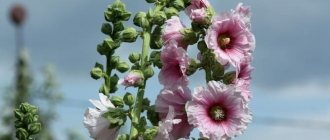Author: Elena N. https://floristics.info/ru/index.php?option=com_contact&view=contact&id=19 Category: Garden plants Published: January 26, 2019Last edits: January 20, 2021
- Soil preparation
- How to care
- Wood mallow (Malva sylvestris)
- Musk mallow (Malva moschata)
It's drizzling endlessly. Only the hollyhocks shine, as if there is a cloudless day above them. Basho
Malva is a beauty that you can’t hide behind a fence! And why? After all, this is definitely not why breeders worked so hard on flowers of jewelery beauty in all possible shades: from virgin white to blue-black! Did you know that the closest relatives of mallow are kalachiki (wortwort) and marshmallow? From the first, the hollyhock inherited unpretentiousness and pretty rounded leaves, and from the second – many healing and even magical properties! It is believed that mallow planted along the fence protects the house and all its inhabitants from the evil eye and evil. But it turns out that not all hollyhocks will do well near any fence... How to please a hollyhock so that it blooms for 4 months in a row, read on.
Planting and caring for mallow
- Planting: sowing seeds in May-June in open ground or in January-February for seedlings (planting seedlings in the ground - in mid-May).
- Flowering: mid-summer.
- Lighting: bright sunlight, light partial shade.
- Soil: rich in humus, well-drained, average moisture, neutral.
- Watering: moderate to abundant, regular.
- Garter: recommended, especially for tall varieties.
- Fertilizing: before budding with complex mineral fertilizer with a predominance of nitrogen.
- Reproduction: seed.
- Pests: slugs.
- Diseases: rust, powdery mildew.
Read more about growing mallow below.
Mallow (lat. Malva) , or mallow , or kalachik , or hollyhock , is a type genus of the Malvaceae family - a herbaceous plant, usually annual, sometimes biennial and perennial. Today, about 30 species of mallow grow naturally in the temperate climates of North Africa, North America, Asia and Europe. Mallow was cultivated in Ancient Egypt and Ancient Greece: a description of the healing properties of the plant was found in the works of Hippocrates and Pliny the Elder. In the twenties of the last century, scientists discovered ecological plasticity and high feeding qualities in mallow. And large bright pink flowers have always aroused the admiration of artists who depicted them in paintings and poets who sang them in poetry. And how can one imagine a Ukrainian hut without a mallow growing next to it in the front garden? Or a Ukrainian towel without its bright pink flowers...
Applications of mallow
As mentioned above, mallow is not only beautiful, but also very useful.
All parts of the plant can be used as medicine, but the strongest concentration of beneficial substances is in the root. Its decoction has anti-inflammatory and expectorant properties, enveloping the mucous membrane, and is used for diseases of the respiratory tract, cardiovascular system and gastrointestinal tract. Green mallow fruit. Photo from the site lepestok.kharkov.ua Moreover, mallow and many other varieties of marshmallow are edible, the leaves and roots can be boiled, stewed, and young fruits and shoots can even be eaten raw, they taste very pleasant. You may also know this plant as mallow or “kalachiki” - for the shape of the fruits located in the axils of the leaves.
“Kalachiki” are very popular among children, but they are usually “obtained” from a wild, inconspicuous relative of the mallow, the low mallow (Malva pusilla).
Low mallow, or low mallow
He is not very pretentious, and few would suspect that the tall, beautiful pink mallow and the low mallow creeping along the ground are closest relatives. And in many countries, mallow is even grown specifically as a table green; usually, annual curly mallow is cultivated for this purpose.
Botanical description
The most famous and ancient representative of the genus woodland mallow is a plant with a straight, recumbent or ascending stem 30-120 cm high, at first fluffy and hairy, and then bare. The leaves of the mallow are heart-shaped, round, notched or five-seven-lobed, pubescent, petiolate. Large, up to 12 cm in diameter, flowers in the shape of a wide bell with characteristic purple stripes of 1-5 pieces are hidden in the axils of the leaves. In some species, the inflorescences form racemes.
Mallow blooms from June to August, it is frost-resistant, drought-resistant and easy to care for.
- Pruning conifers at the beginning of autumn - don’t delay it!
Depending on the variety, single or double flowers vary in color from almost black to white. Petals are oblong, obovate, deeply notched. The mallow root is spindle-shaped, branched, and long. The fruit is polyspermous; the seeds remain viable for 2-3 years.
Description and features of terry mallow
Hybrid mallow was bred by crossing pink hollyhock and wrinkled hollyhock. Only this plant can have double flowers. Outwardly, they are very similar to peonies, but their flowering period is much longer. The first inflorescences bloom in early summer, new buds open until autumn. The color of the petals can be the most unusual: from white, peach to dark purple.
Today there are many varieties of royal flower. These are plants with a peduncle height of up to 75-200 cm. Their inflorescences are large, reminiscent of a carnation or peony, the edges of the petals are carved and wavy. The colors are bright and attractive. Flowers bloom from bottom to top and retain their freshness for a long time when cut.
Terry mallow is a perennial or biennial plant, which is often grown as an annual from seeds. However, in order to see flowering this year, it is better to plant pre-prepared seedlings. Otherwise, the mallow will bloom only after a year.
Terry varieties winter well in open ground, but they need to be protected from severe frosts. That is why in regions of harsh agriculture the plant is cultivated as an annual. After all, the heat-loving mallow does not tolerate difficult weather conditions.
Growing mallow from seeds
Growing conditions
If you don’t want to make extra efforts and are in no hurry to see the mallow blooming this year, you can sow the seeds directly into the ground in May or June. But then your mallow will only have time to form a rosette of leaves before the onset of winter, and will bloom only next year. If you want the mallow to bloom this summer, you should sow seeds for seedlings in January-February.
But even if you are ready to grow mallow as a biennial or perennial plant, the seedling method is still more reliable than the seed method.
For both annual and perennial mallow, this process is the same, the only difference is when to sow. Annual mallow is sown in mid-winter, planted in the ground in May, and blooms in mid-summer. Biennial and perennial mallow is sown in May and planted in the ground in August or September.
Growing seedlings
It is advisable to soak mallow seeds that you have stored for a year or two or purchased at a flower shop for 12 hours in warm (45 ºC) water before planting in order to soften the hard seed shell and facilitate the germination process.
It must be said that mallow seeds, which remain viable for up to three years, germinate much better in the third year of storage than in the first two years.
To sow mallow for seedlings, it is better to use peat pots, since the roots of the mallow do not tolerate transplantation well and often do not take root in a new place. The temperature for seed germination should be 18-22 ºC, then seedlings will appear in two weeks. If you sowed mallow in a container, then after three leaves appear on the seedlings, you will have to thin them out so that there is a distance of 2-3 cm between the seedlings. The removed sprouts can be saved by carefully planting them in peat pots. When the seedlings grow and become stronger, they need to be hardened off by placing them in fresh, cool air for several hours. In May-June, seedlings can be planted in the ground directly in pots.
In the photo: Growing mallow seedlings from seeds
How to grow strong mallow seedlings: we care for them according to all the rules
Any gardener, even the most beginner, can grow strong, healthy and good mallow seedlings! To do this, you just need to know the peculiarities of agricultural cultivation technology, and not just know, but implement the rules of care in practice!
So, in order to properly care for mallow seedlings at home, you need to do the following:
- Immediately after sowing, before germination, a mini-greenhouse , that is, containers with seeds must be covered with a lid, cling film, glass or other covering. Greenhouse conditions are necessary for good germination.
- ventilated every day (or at least every other day) to avoid waterlogging of the soil, which can provoke the proliferation of fungi and mold. It is enough to ventilate for 20-30 minutes. And before closing the container, it is important to wipe off the condensation from the covering material with a clean napkin.
- Before emergence, it is necessary to carefully monitor the moisture content of the soil surface . The earth should never dry out! Indeed, in this case, the seeds will also dry out, which means they will die and will never be able to sprout again. If the soil surface dries out slightly, you should immediately irrigate it with a spray bottle.
- Temperature for seed germination: 20 degrees. Shoots will appear in about 2 weeks.
- When shoots appear, it is necessary to remove the cover . However, it is undesirable to do this right away, because a sudden change in conditions can cause stress in plants and slow growth. It is advisable to remove it for 1-2 hours in the morning and evening on the first day, remove it in the morning and cover it at sunset on the second day, remove it completely on the third day.
- temperature : 18-20 degrees during the day, 16-18 at night.
- It is important to provide mallow seedlings with adequate lighting : 12-14 hours a day. If there is not enough natural lighting at home, then it is highly advisable to supplement the plants with phytolamps (morning and evening). With a lack of light, the seedlings will begin to stretch. When pulling, you need to immediately adjust the lighting. It is also effective to pour with a retardant drug, for example, Atlet (strictly according to the instructions).
- For successful growth and development, it is necessary to regularly water the mallow seedlings. Watering is carried out when the top layer of soil dries (1-1.5 cm). The root zone is watered with a weak stream without pressure; it is very convenient to use a syringe or syringe. In this case, the water must be at room temperature (t 20-22 degrees), clean, settled (at least 24 hours). Watering with cold water can cause stress and fungal diseases!
- Periodically after watering (every couple of hours) it is useful to loosen the soil surface . This maintenance procedure improves soil breathability and prevents the formation of soil crust. Loosening depth: no more than 1 cm.
- When the plants have their first true leaf, it is necessary to thin out the seedlings (if you sowed 2-3 seeds in one container at once). You need to leave one, the strongest plant!
Picking seedlings
If it so happens that you planted mallow seeds in a common box, then when the first 2-3 true leaves appear, you need to pick out the seedlings. Plant the seedlings in single cups with a volume of 350-400 ml.
To pick, you need to water the ground in advance, and then pick up one seedling at a time with a stick or spatula along with the roots, and then plant it in a new container.
After transplanting, be sure to water the picked plants with the root formation stimulator “Kornevin”, or the growth stimulator “Epin”, “Zircon” or others. A few days after the procedure, it is useful to spray with a solution of Epin, Zircon.
Note! As mentioned above, standard picking is undesirable, since mallow seedlings critically survive any (even the slightest) injury to the roots.
If the mallow seeds were planted in small cups with a volume of 100-150-200 ml, then after the formation of 3-4 true leaves it is advisable to transplant the seedlings into larger containers (350-400 ml). Transplantation must be done using the transshipment method, that is, you need to remove the plant with a whole earthen lump from the old container and plant it in a new container filled with earth. In order for the lump of earth to remain intact, it must be watered 2 hours before transplanting.
Planting mallow
Soil preparation
Choose a sunny area in the garden (mallow grows in partial shade, but loses its bright color and stem height) with good drainage and loose loamy, humus-rich soil. The place for sowing should be high to prevent rotting of the roots from standing melt water. It would be nice if the area was protected from winds and drafts. It is best to plant mallow along the fence: there will be a support nearby to which you can tie the stems. If your soil is poor, you will have to fertilize it by mulching the area with humus. But more on that later.
How to plant in the garden
Seedlings of annual mallow are planted in open ground in mid-May. Seedlings of two-year or perennial mallow are planted in the ground in August-September. Seeds of biennial and perennial mallow can be sown directly into the ground. This is done in the spring, in April-May, after late frosts. Small holes are made in the soil up to 3 cm deep and 2-3 seeds are placed in each hole.
Depending on what variety of mallow you are planting, the distance between seedlings should be from 25 cm to 50 cm.
The hole is filled in, the soil is pressed down and moistened. If you are not sure that summer has finally arrived, place covering material on your bed so that the sprouts are not damaged by possible frosts. Under favorable weather conditions, the seedlings will hatch in two weeks. When the seedlings have 3-4 leaves, they need to be thinned out, leaving one tall seedling in the hole.
Planting hibiscus in the garden - all the information you need
Mallow propagation methods
Perennial mallow is propagated in one of three main ways: growing from seeds, planting seedlings, and cuttings.
Sowing seeds in open ground
Typically, mallow seeds are sown in summer, in June. Seeds are sown on a dug up area, placing them directly on the surface of the soil and sprinkling with a thin layer of soil.
Mallow sowing seeds in the ground
The gardener determines the distance at which plants need to be placed from each other depending on the type of flower. More compact and low-growing plants can be sown at a distance of 40-45 cm, tall ones require more space, so they are sown at a distance of 60 cm.
You can also make shallow furrows in the soil and plant the seeds in them.
Sown seeds need to be watered regularly. In the third week after planting, the mallow seeds will sprout. The first flowers will appear on the plant in the second year of life.
In autumn you can also sow perennial mallow. The sowing technology is changing somewhat; now small holes up to 3 cm deep need to be prepared for seeds. The intervals between holes also range from 40 to 60 cm and depend on the plant variety. Loose soil or peat is used to sprinkle the seeds. Autumn crops of mallow need to be prepared for winter by carefully covering them with leaves.
Planting seedlings
To transplant mallow seedlings to a permanent place in the summer, from July to August, sowing seeds for seedlings begins in March. As when grown from seeds, their flowering begins the next year after planting. However, with early planting of seedlings and, accordingly, early transfer of plants to a permanent place in the ground, flowering is possible already in the year of planting.
Mallow sowing for seedlings
Cups should be prepared for future sprouts. They should be spacious and large: the plant and its roots will need space. The cups are filled with soil mixture. It is advisable to use special soil for flower planting.
The technology for sowing seeds is the same as when sowing them in the ground. Several seeds are placed on the surface of the soil and lightly sprinkled with soil. Then each glass of seeds is spilled with water. For normal development, keep the container with peat cups in a warm place (not lower than 18°C), avoiding drafts, and water it regularly.
Picking mallow into the ground is possible, but not necessary. If you want to dive, you should wait until the third full leaf appears on the plants. For picking, the strongest sprouts are selected, which then continue to grow in a greenhouse or in a room with a constant room temperature, waiting to be transferred to a permanent place.
But you can continue to grow seedlings in the same spacious peat cups in which the seeds sprouted.
It is useful to take the container with seedlings out into the open air 7-10 days after planting. In this case, adaptation to street temperatures will be easier.
Propagation by cuttings
Cuttings are usually used when they want to plant a specific variety of flower they like on a plot. Cuttings can be carried out in spring and summer. In spring, the cuttings are cut off at the bottom of the plant, closer to the root. In summer, the cuttings are cut from the stem.
If the cutting method is chosen for plant propagation, you should prepare for the procedure in advance and disinfect everything necessary:
- A knife that must be very well sharpened. The sharpness of the knife should allow you to easily and effortlessly cut the required part of the plant.
- Crushed charcoal. Used to sprinkle the flower cut.
- A pot with soil mixture for planting cuttings.
The procedure for cutting mallow is traditional. The cuttings are cut, the wounds are treated, and after the surface of the wound has dried, they are planted in a prepared flower pot and watered abundantly. The cuttings remain in the pot until transplanted into the ground. Cuttings do not always give the desired result; it requires experience and a certain skill. Therefore, more cuttings are harvested than the number of flower plantings expected. The more experience the grower has, the better the ability to take cuttings of mallow.
Mallow care
How to care
Growing mallow is a simple process, since mallow is not a fussy plant. Regular moderate watering, especially in dry summers, loosening the soil and weeding, timely removal of wilted flowers are mandatory requirements for caring for mallow.
- A new way to cover figs for the winter without digging - making autumn work easier
In addition, it would be good to feed the plant before budding with mineral fertilizers with a predominance of nitrogen.
A tall mallow needs staking to prevent it from breaking under strong gusts of wind, so plant it along the fence or dig in high pegs to secure the plant. Well, if you want to make a perennial from an annual, immediately after the mallow has bloomed, cut off all the flower stalks so that the seeds do not have time to set. That's all for caring for mallow.
In the photo: Mallow flowering in the garden
Diseases and pests
Mallow is attacked by slugs. They are collected by hand: place small bowls in different places, pour beer into them, and after a day, walk around and collect the slugs that come crawling to get drunk.
Of the few diseases that affect mallow, the worst is rust, which can easily be contracted near metal fences. The disease manifests itself in the appearance of dark red spots on the back of the leaves. Affected leaves should be removed and burned.
Sometimes powdery mildew appears on mallow. You can fight it with a solution of colloidal sulfur or a specialized fungicide.
In the photo: Pests of mallow on a flower
Mallow after flowering
In the fall, after the mallow has bloomed, the stems are cut down to ground level. At the same time, you can fertilize the soil by mulching it with humus and compost at the rate of 3-4 kg per 1 m2. Mallow should overwinter under cover of spruce branches, fallen leaves or straw.
In the photo: Mallow has bloomed
Rules of care
Caring for your favorite family member comes down to five main activities:
Watering. Frequent watering of the plant is not required - a couple of times a week is enough for them to feel comfortable. This is primarily due to the deep root system, capable of extracting moisture from the lower layers of the soil. However, if the weather is hot and dry for a long time, then it is recommended to either water more abundantly or more often, once every two days. Also, more abundant watering will not hurt during the budding period. The main thing in watering is to avoid stagnation of water, which increases the risk of fungal diseases.
Loosening or aeration. It consists of timely removal of weeds and periodic loosening of the top layers of soil. The most important thing when loosening is accuracy - if you damage the roots it can lead to the death of the plant.
Feeding is recommended at least twice a season - at the beginning of the season and during budding. Organic fertilizers are used for feeding: humus, peat or compost.
Garter. Most mallows are quite large plants, and this can often lead to damage. That is why they are most often planted next to fences, or to decorate the walls of buildings. As a last resort, you can prop up the bush with a peg.
Protection from diseases and pests. In moderate weather conditions, diseases are not dangerous. Risks of disease appear during prolonged and frequent rains, or due to stagnation of water after heavy watering. Of the pests, the most dangerous are aphids (and where there are aphids, there is an anthill and vice versa) or spider mites. It is treated with insecticidal preparations, which can be purchased at any specialty store.
The healing properties of mallow
Mallow has long been known in folk medicine. The beneficial properties of mallow have been studied by healers in many countries. For example, an infusion of mallow flowers and leaves treats inflammation of the stomach and intestinal disorders. Hot baths with steamed leaves or flowers of mallow (wood mallow) help relieve swelling of the spleen. The wild mallow herb is a constant component of breast collections.
Lavatera: planting and caring - a relative of mallow
In the form of lotions and compresses, a decoction of mallow flowers is used for skin diseases to relieve itching and to heal wounds (obviously, due to the mucus contained in mallow). Mallow is also used in medical cosmetology to restore the epidermis and prevent pustular rashes. Preference in folk medicine is given to mallow flowers, since they contain higher levels of sugars, vitamin C and carotene than the leaves. The main thing is that preparations from mallow do not give unwanted side effects and have no contraindications.
Beneficial properties of mallow:
- expectorant;
- emollient;
- reparative;
- enveloping;
- anti-inflammatory;
- restorative.
Mallow tea for coughs: pour 2 teaspoons of finely chopped flowers (or leaves) into a glass of boiling water and leave for 10 minutes, strain, drink 2-3 cups a day. You can add honey, but then the tea should be no warmer than 40 ºC.
… Every year in May, Kyoto’s Kamigamo Temple and the city host the Aoi Matsuri festival, dedicated to mallow. People put on bright clothes and walk through the streets of the city dancing and singing. This holiday is many centuries old...
The May rain is endless... The hollyhocks are reaching somewhere, Looking for the path of the sun. Basho
Disease Control
Among the diseases that most often affect perennial mallow are powdery mildew and leaf mosaic. It happens that its leaves are covered with brown spots of rust. When the first signs of the disease appear, all diseased parts of the plants should be removed and burned, and the bushes should be treated with Bordeaux mixture and appropriate preparations. To prevent diseases, you should not plant perennial mallow for 3-4 years in areas where crops that were susceptible to the same pathologies previously grew.
The consequence of waterlogging the soil under plants can be the appearance of slugs. Among other pests, mallow is most often affected by spider mites or aphids. Insecticidal or folk remedies can save you from them. For example, a soap solution of dry mustard effectively fights against aphids.
Types and varieties of mallow
The genus mallow in cultivation includes about 60 species of ornamental plants. The ancestor of this genus, woodland mallow, is an annual plant. And species such as Sudanese mallow, hybrid, musky and wrinkled are predominantly perennials. True, it must be said that not all flower growers include all these species in the mallow genus, considering, for example, that the Sudanese mallow, or hibiscus, as well as the wrinkled mallow, or rose hollyhock, although they belong to the mallow family, are related to to another kind. Let’s not quibble: the plants are so similar in characteristics that it makes sense to combine them into one section on care and cultivation.
Where can you plant mallow?
In our gardens, mallow is an indispensable tall flowering plant in the background.
It looks great along walls and as a decoration for hedges. Mallow near houses Mallow has become very popular as cut flowers and in mixborders in combination with shorter and completely dwarf plants. And in compositions with cosmos and decorative sunflowers it can not only break up the space, but also create a tall “jungle” with a minimum of care. Many people use stockrose in combination with phlox, but for me this composition is too aggressive.
Mallow annual
Wood mallow (Malva sylvestris)
So, forest mallow , or Kalachiki . This biennial plant is grown in our country as an annual one. It grows up to 120 cm, its flowers are characterized by the presence of darker veins than the color of the flower. Popular varieties are mallow zebrina, characterized by large flowers of soft pink color with dark red veins. The Black Mother of Pearl variety is also in demand - dark purple flowers up to 7 cm in diameter with black veins.
In the photo: Wood mallow or kalachiki
Site selection
The place for growing terry mallow should warm up and be well lit during the day. An open area, but protected from cold winds, is preferable. In the shade, the stems of the plant stretch out, and the number of inflorescences decreases significantly. Some varieties refuse to bloom at all in such conditions.
The soil for planting should be loose, fertile, but well drained. The flower can grow on poor soil, but for full flowering it needs regular feeding.
Important! The ideal soil for terry mallow is loam. But other soil will do just fine.
Before planting, the area is prepared in advance. If necessary, add sand, humus and peat. After which the flowerbed is dug up to a depth of 20-25 cm. Seedlings of terry varieties are planted at a distance of 50-60 cm from each other; the plants are vigorous, grow quickly and interfere with each other.
perennial mallow
Musk mallow (Malva moschata)
It is a low perennial - no higher than a meter. The fragrant flowers of white or pink musk mallow reach a diameter of 5 cm. This mallow is sometimes called nutmeg mallow. Popular varieties are White Tower and Pink Tower, 70cm tall with snow-white or hot pink flowers respectively. These varieties bloom until frost.
- Sowing lobelia seeds for seedlings in bunches and in bulk
In the photo: Musk or nutmeg mallow
Sudanese mallow
Or Hibiscus Sabdariffa , or Sudanese rose - a biennial plant grown for its fruits, which have long been one of the components of fruit drinks that have medicinal value. The known bush form is Malva sabdariffa var. Sabdariffa and the tree form Malva sabdariffa var. Altissima.
In the photo: Sudanese mallow or hibiscus sabdariffa or Sudanese rose
Wrinkled mallow (Malva rugosa)
Rose stock , or wrinkled alcea - it is conventionally called mallow. The plant in nature reaches two meters in height, its flowers are 3 cm in diameter, yellow. It is a perennial. Garden form - pink hollyhock, or rose hollyhock (Malva alcea). The plant is a perennial, reaches 90 cm in height. It has varieties with both simple and semi-double and double flowers, similar to peonies.
For example, the Chater's Double Strein variety is a double mallow with large flowers of different colors, while Single Mixed has simple flowers reminiscent of hibiscus. Stock rose varieties also differ in size: the Powder Puffs Mixed variety, for example, reaches a height of two meters, and Majorette Mixed is a dwarf plant (up to 75 cm), but with large semi-double flowers.
In the photo: Rose hollyhock or rugose mallow or rugosa alcea
Hybrid mallow (Malva hybrida)
It is a perennial with several stems, height up to 2 m. The flowers are white or pink, double, very large. Blooms in June-September. Popular varieties: Chaters Double, Gibbortello, Powder Puffs.
In the photo: Hybrid mallow
You should know that almost all varieties of forest mallow are annuals, and varieties of other types of mallow are mainly biennials or perennials, but this division is arbitrary: both among the varieties of forest mallow there are perennial varieties, and among the conventional perennials there are annual varieties.
Plant characteristics
Mallow also has other names - mallow, stockrose, marshmallow. More than 3 dozen varieties of flowers are found in nature, including annual and perennial, wild and cultivated species. Most of them are represented by herbaceous plants growing up to 2 m. They are indispensable in landscape design and look great both in single and group plantings, and can become an excellent colorful background for smaller plants in flower beds. Thanks to the long flowering period, terry mallow remains a decoration of the site until mid-September.
Use in landscape design
With the help of terry mallow you can achieve a wonderful look in the garden or park. It is better to plant it along fences or under a wall in a row as densely as possible in the form of a colored plant fence. In this case, you can combine varieties and colors. The beautiful dense inflorescences of mallow and its size and growth can disguise any unattractive areas of the garden, cover up the appearance of buildings or fences.
Annual low varieties look impressive in large pots, looking like lush bouquets.
Colored hollyhock fence
Many people consider the common mallow to be a weed and try to remove it from their garden. This is due to the fact that some varieties of the crop have high vitality, grow quickly, and are not so easy to say goodbye to. But it is worth paying attention to the fact that currently there are many varieties of plants that will become a worthy decoration of the garden and will help to remove all the unsightly corners of the site. Mallow will not go unnoticed; the gardener will have something to be proud of!
Growing mallow in greenhouse conditions
Stockrose seeds planted in the open ground in May - June will not have time to please the gardener with beautiful buds before the onset of cold weather. Therefore, many, especially impatient people, try to grow flowers through seedlings in greenhouse conditions. To do this, prepared seeds are sown in greenhouses in February and no later than March. In this case, the first flowers will bloom in late July - early August.
Since mallow is a heat-loving plant and is afraid of excessive watering and high humidity, it is necessary to maintain an appropriate microclimate for the plant by installing good ventilation. How to grow mallow healthy and disease-resistant? She is not picky about the composition of the soil, but it is better for the seeds to be planted in loose soil with good aeration. For example, two parts of earth and one each of sand and humus. Before planting in a greenhouse, they are soaked in warm water for 12 hours. The best option would be to grow seedlings in special cups or peat pots. If there are no glasses, then the seeds are placed at a depth of 2-3 cm and at a distance of 3-4 cm from each other.
After planting the seeds, they are covered with a thin layer of soil, well moistened and covered with film. In order for flowers to thrive in greenhouse conditions, the air temperature must be at least 18ºC. Similar conditions are suitable for seedlings. As soon as the seeds germinate, the film can be removed.
What a gardener needs to remember
Experienced flower garden owners not only grow beautiful hollyhocks on their own, but also share their little secrets:
- Seeds stored for 2-3 years have the best germination;
- by planting mallows of different varieties nearby, you can achieve cross-pollination;
- It is better to plant plants with different flowering periods in flower beds;
- To be sure of the abundance of seedlings, it is better to sow the seeds in the ground 2-3 pieces together. If they all sprout, they can be thinned out;
- flowering will be more abundant and brighter if mineral fertilizers are added to the water when watering;
- Mallow blooms from June to October, making it a versatile flowerbed plant that blooms all summer.
Perennial mallow is widely used in folk medicine. All parts of the plant are beneficial, including roots and leaves. Rose stock is also used in cooking and industry.
Mallow is widely used in folk medicine
Perennial mallows are divided into several types:
- Sudanese mallow. She is also a Sudanese rose or hibiscus. It is grown mainly for its flowers and fruits. A shrubby and tree-like form is known;
- musky or nutmeg mallow. Low type (up to 1 meter). It has a pleasant aroma and long flowering;
- tree mallow. She is also a garden hibiscus. Differs in height up to 3 m, cultivated as a tree or as a bush;
- wrinkled mallow. This species is often called the stock rose. Height may vary depending on the variety. It is distinguished by the presence of varieties with semi-double and double petals;
- hybrid mallow. It is distinguished by a wide variety of varieties with petals of different colors.
A beautiful and useful plant that has virtually no disadvantages in growing, mallow will not lose ground for a long time. It will remain in demand and interesting for flower growers from different countries. It is rare to find such a beautiful and unpretentious flower as mallow, the planting, care and cultivation of which is within the power of everyone.
{SOURCE}
Favorite varieties of gardeners
Nemesia - planting and care in the garden
Only wild mallow grows in nature; all other types of mallow are grown specially. Today, many seeds are sold for growing both common mallow and new, selective varieties and colors of annual and perennial mallow.
There are more than 30 varieties of mallow. Each has its own characteristics. Knowing their descriptions, the gardener can easily choose the right plant for himself.
Chater's Strein variety
The variety has double flowers up to 15 cm in diameter; the flowers are very similar to peonies. The height of an adult stem reaches 2 meters.
Mallow Chaters Strain
Pinafore Mixed variety
This culture has glossy, double or simple flowers, many colors, but no scent. The stem of the plant reaches a height of 1 meter.
Pinafore mixed
Variety Majorette Mixed
One of the popular varieties. The flowers are semi-double, large, stem height is up to 75 cm. Majorette has all the primary colors of mallows.
Majorette mixed
Queeny Purple variety
A hybrid created by crossing marshmallow and pink mallow. It has an average height of 75 cm.
Queenie purple
Variety Creme de Cassis (Creme de Cassis)
This mallow is perennial, but is more often grown as a biennial. The height of the bush is from 1.5-2 meters in height. The culture is unusual - it can have simultaneously single-flowered, two-flowered, semi-double and double inflorescences with a diameter of up to 12 cm on one peduncle. The coloring is also ambiguous - it is white at the edges, and varies from red to dark brown towards the middle of the bud. Grows well in partial shade and sun.
Creme de casis
Variety Peach'n'dreams (Peach and Dreams)
Flowering of this variety begins in June and continues until autumn. The diameter of the buds is 10 cm. Their color is peach or pinkish. The buds consist of corrugated-wavy dense petals; in general, the flowers resemble a pom-pom or peony. The plant is perennial.
Peach and Dreams
Other common varieties
Eschscholzia flowers - planting and care in the garden
Almost everyone knows what a mallow flower looks like. When its name is mentioned, one imagines a tall, human-sized plant, densely strewn with flowers and found absolutely everywhere. A flower from childhood. Children love to make earrings and tufts from mallow petals; they stick easily to the skin, since the juice of the mallow flower is sticky.
On a note! Some species are found everywhere, but not everyone knows what their differences and features are.
Musk mallow
This variety is low - from 20 cm to 1 meter. Has a musky aroma. The stems are straight, rough, densely covered with hairs. The diameter of the flowers is up to 5 cm, the color is white or pink. The culture requires good lighting of the site and does not like wind. Grows on soft soils. The most popular varieties of musky mallow are Pink Tower, White Tower, White Perfection.
Malva woodland
It grows in the wild in forests and park areas in North-West India, Central and Asia Minor, northern Africa and Europe. But gardeners also grow it on plots.
Forest mallow is squat, with a height of 30 to 120 cm. The plant is biennial. Stems are smooth and straight. Famous varieties are the dark purple Black Pearl and the light pink Zebrina. There is also a variety of woodland mallow, Blue Fontaine, which grows up to 70 cm, and its flowers are purple with a blue border.
Mallow wrinkled
This is a perennial bush mallow, not classified according to special indicators, it is not customary to classify it as a separate species. But many flower growers are sure that this plant is not related to the mallow family.
Sudanese mallow
A wild plant found in Turkey and Greece, it is cultivated for its fruit. This variety has a second name - Hibiscus Sabdariffa. The plant has 3-5 stems up to 2 meters high. The color of the buds is black and red.
On a note! This biennial plant blooms from June to late autumn.
Mallow pink
The bud color of this light mallow is creamy pink. They are densely collected in inflorescences. The height of the stems is 2 meters. Grows well in moist and sunny places. The perennial blooms in the second year after planting.
Hybrid mallow
The plant has several stems and reaches a height of 2 meters. The variety blooms from June to September.
Description
Mallow has several names: mallow, rose stem and kalachik. The flower belongs to the Malvaceae family , and the genus unites about 30 varieties, among which there are not only tall ones, but also double and short ones.
In its natural environment, mallow can be found in temperate climates in North America, Europe, Asia and the northern regions of Africa.
The height of plant shoots can vary from 0.3 to 1.2 m. Mallow shoots can be creeping, vertically oriented or ascending. The stems of young mallows are covered with a distinct down, which disappears over time.
Large leaf plates have a round shape, reminiscent of a heart. They are attached to the stem on a small petiole and covered with short fluff.
The color of the leaves is rich green, the leaves can have from 5 to 7 lobes; There are also leaves with a notched edge.
The corollas of the mallow are large, their outlines reminiscent of a bell . The diameter of fully opened buds can reach 120 mm.
The color of the petals is completely dictated by the varietal characteristics of the plant. The variety of colors covers the palette from white to deep purple, almost black tones. The petals have an oval, inversely curved shape.
Mallow has a well-developed spindle-shaped root that goes into the ground to a decent depth.
Interesting! Mallow is resistant to temperature changes and can withstand both severe droughts and frosts with equal resistance. The flowering of the crop, starting in the first half of summer, lasts until the onset of autumn frosts.
Possible problems in growing
All types of plants are susceptible to disease and have their fans among insects. When growing mallow, small and large problems also arise; each of them has its own techniques and means of protection in the form of drugs.
Pests and diseases
The most common disease is mallow “rust,” when some or all of the plant’s leaves become covered with red spots on the inside and dry out. Such parts must be removed in a timely manner to tidy up the appearance and so that the disease does not affect neighboring parts. Rust is a fungal disease and must be controlled with antifungals or garden fungicides. It is better to immediately treat young seedlings with one of the solutions of colloidal sulfur, Bordeaux mixture or copper oxychloride.
During dry periods, the crop may be attacked by caterpillars, thrips, aphids or spider mites. They suck out the sap of the plant, leaving behind dried and curled leaves and flowers. You need to pay attention to the back of the leaves - there may be clutches of insect eggs there.
At this time, you need to completely spray the plant with water to knock down insects, and treat it with special garden preparations.
Mallow rust disease
Signs of improper care
The main signs of an unhealthy plant or improper care for it are dry leaves and trunks and little flowering. If the gardener is concerned about the further viability of the crop, measures must be taken to restore it. Otherwise the plant will be lost.
Features of planting a flower
Although the mallow flower is not demanding in care and cultivation, it still requires compliance with certain rules when planting.
How to choose a place
Planting and caring for mallow begins with the right location for the plant. She loves light, and blooms with faded flowers in dark areas. Also, you should not choose a place where strong winds blow.
What kind of soil does mallow like?
Particular attention is paid to the composition of the soil. When planting perennial mallow, light loams are selected. If the soil on the site is not rich in nutrients, then it is additionally fertilized with compost or manure. If we are talking about heavy loamy soil, it is diluted with peat and sand. And if the soil is too sandy, peat and clay are added to it.
Attention: it is forbidden to plant mallow in places where water accumulates, that is, in lowlands. Also, it should not be planted in areas with close groundwater. It has a very capricious root system, which immediately begins to rot if there is an excess of moisture.
How to sow seeds in open ground
Terry mallow, like its other species, reproduces in different ways: seeds, cuttings, seedlings. Planting the plant with seeds is suitable for regions with a warm climate, where the soil warms up well in the spring.
For sowing, purchased or independently prepared seeds are used. If you collect the seeds yourself, you should do this after the plant has flowered and the capsules appear on it. They are carefully picked from the bushes when they acquire a dark brown color and open slightly (but not completely). After picking, the seeds are stored in a warm place. They will ripen and open up on their own.
After the seeds spill out of the box, it is recommended to dry them for several days and store them in a dry place.
Attention: mallow seeds remain viable for three years after collection if they are stored properly. But independently collected seeds do not always retain the decorative qualities of the plant. Experts still recommend buying them in garden stores.
Sowing of seeds is carried out either directly in open ground or in pre-prepared seedling boxes. It is best to sow them in late April - early May.
The landing process itself is as follows:
- The soil in the flowerbed is well dug up to a depth of 25 cm, leveled and moistened.
- The seeds are soaked for 10 hours in warm water and laid out on the surface of the soil.
- Then the flowerbed is covered with earth.
Attention: the distance between low-growing varieties is 45 cm, between tall varieties up to 70 cm.
The first shoots will appear after a few weeks.
Important: if we are talking about an annual plant, it will bloom in the same year. If a two-year-old mallow was sown, it will bloom only the next season.
The nuances of planting mallow seedlings
Planting mallow seedlings is carried out in those regions where the soil does not warm up well in the spring, that is, in a temperate climate. Since planting a plant with seeds in cold soil will not give results. They just won't germinate.











